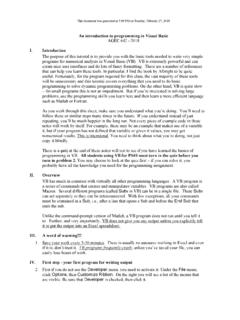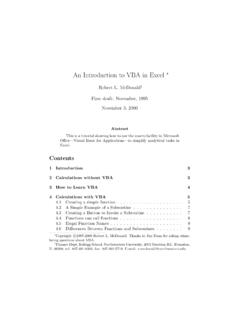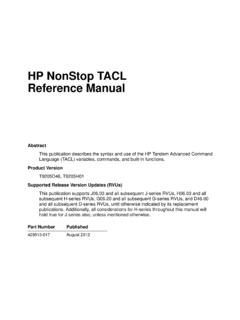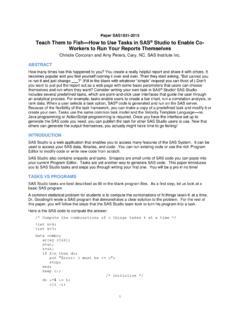Transcription of Paper 272-2011 Tips and Techniques for the SAS …
1 SAS Global Forum 2011 Programming: Foundations and Fundamentals Paper 272- 2011 . tips and Techniques for the SAS Programmer Helen Carey, Carey Consulting, Kaneohe, HI. Ginger Carey, Carey Consulting, Kaneohe, HI. ABSTRACT. If you are new to programming or even are an experienced programmer, you will benefit by learning tips and Techniques that will help you be more productive. This presentation offers tips in programming, efficiency, work habits, and where to find answers to your SAS questions. These tips come from our own experience and from learning from others through their presentations and papers. INTRODUCTION. While helping many SAS users at a university, we have found them writing programs the hard way.
2 If they had only learned about dates or functions or this or that procedure or learned how to use the available resources, they could have saved themselves a lot of time and frustration. However, when using SAS software, you quickly discover that there are many ways to achieve your results. A search on the internet for SAS tips , SAS resources or SAS efficiency results in thousands of hits. Also there are SAS Press books that focus on SAS tips . Our tips range from simple timesavers to opinions on how to generate the results. Many of the tips are brief with a reference to a Paper or a page on a website with in depth information about the topic. The topic is worth pursuing in greater detail than can be given in this Paper .
3 The Recommended Reading section at the end of this Paper lists where to find the papers.. One of SAS Institute's registered trademarks is the slogan The Power to Know . We are going to use the word POWER to reveal some fundamental tips . Ginger thought that the title of this Paper should have been "The SAS. Solution: The Power You Don't Know You Have." That sounds like a future Paper . These are the topics identified by the acrostic POWER. P Procedures O Output W Work Habits E Efficiency R Resources The topic data is not part of the acrostic POWER. Because everything starts with the data, that is where we will start. DATA. Know Your Data Needing to know the data is something that we learned first-hand.
4 We were analyzing and reporting on data collected from senior citizens. The analysis indicated that many were exercising more than 4 hours a day. That was not how I. pictured retirement. The data was supposedly clean and it was. By running a PROC FREQ and PROC. UNIVARIATE, we discovered many retirees enjoyed gardening for 4 to 8 hours daily. Gardening was considered an exercise. Another time we had to inform a researcher that his published results on a public website were incorrect because he did not understand how the missing values were coded. Therefore, know your data. Check data values, range of values, frequencies of values, missing values, index variables with unique values, complete and consistent dates, required variables, and duplicate records.
5 A point and click way to check your data is to use SAS Enterprise Guide and the task Characterize Data. With a wizard, you can easily create summary report, graphs, frequency and univariate statistics. For normally distributed data, you can use PROC SQL to select extreme values. proc sql;. select *, avg(score) as mean, std(score) as sd from group by gender having abs(mean-score)>2*sd;. run; quit;. 1. SAS Global Forum 2011 Programming: Foundations and Fundamentals One way to check your data is to use PROC FORMAT to define valid groups and run PROC FREQ on those groups. proc format;. value dosefmt 0,.01-2='valid'.. ='missing'. other ='invalid';. proc freq data=trial;. tables Dosage / missing;. format Dosage dosefmt.
6 ;. run;. Ron Cody's book Cody's Data Cleaning Techniques includes programs and macros for typical data cleaning tasks. Use PROC DATASETS or PROC SQL with the view discussed below to learn more about the variables and their attributes. Data Step If you are not familiar with the data vector, variable attributes, and how SAS processes the data while creating a SAS. data set, then read The Essence of DATA Step Programming by Arthur Li. This Paper explains what happens behind the scenes. A good, basic understanding of how SAS processes and stores data is essential to being a good SAS. programmer. Along with data values, each SAS data set contains metadata or data about the data. This information, recorded in the descriptor portion of the data set, contains information like the names and attributes of all the variables, the number of observations in the data set, and the date and time that the data set was created and updated.
7 PROC DATASETS. To view the descriptor portion, you can right click on the data set in the SAS Explorer window and select view columns or print it with PROC DATASETS. The DETAILS option lists the number of observations, the number of variables, and the label of the data set. This is also a way to find typos of the variable names. For example: proc datasets library=work details;. contents data=highschool;. run;.. Michael Raithel's Paper PROC DATASETS; The Swiss Army Knife of SAS has everything you want to know about PROC DATASETS, a powerful procedure. If you are just changing the attributes of the variables, such as their names, informats and labels, then use PROC DATASETS to do the work for you, not the data step.
8 Use PROC DATASETS instead of the data step to concatenate SAS data sets. For example: proc datasets library=youthlib;. append base=allyears data=year1997;. run;. ViewTable Window The ViewTable window in a SAS session, is an interactive way to view, enter and edit data. It is accessible from the SAS Explorer window by clicking on the data set or view or using the viewtable (abbreviated vt) command from the command box. The command box is below the menu bar. Once you open the ViewTable window, you can select to view only specific columns by typing the columns command from the command box, such as columns 'memname name label'. This is the same as using the hide/unhide on the Data Menu of the ViewTable window.
9 Close the ViewTable window before submitting the program that recreates a SAS data set. More than once, I have not closed the window, have not read the log, and wondered why the results did not change. This is an example of where it is important to read the log after every run. By reading the log, I would have found out that I could not re- 2. SAS Global Forum 2011 Programming: Foundations and Fundamentals create my data set because it was open in the ViewTable window and The SAS System stopped processing this step because of errors. Reading the log after every run is a good practice to follow. The Appendix contains information about opening a ViewTable window the way you want it. Dictionary Tables A DICTIONARY table is a read-only SAS view that contains information about SAS libraries, SAS data sets, SAS macros, and external files that are in use or available in the current SAS session.
10 Each DICTIONARY. table has an associated PROC SQL view in the SASHELP library. You can see the entire contents of a DICTIONARY table by opening its SASHELP view in the ViewTable window. These SAS views name starts with V, for example, VCOLUMN or VMEMBER. was the view that we were using above in the ViewTable Window section. Here is an example of accessing using PROC SQL. proc sql; Results select memname format=$8., varnum, name format=$15., label from where libname='SASHELP'. and memname='ZIPCODE';. run; quit;. Functions Have fun with functions. Use them to save programming time, make the code easier to read and possibly execute faster. There are hundreds of functions in categories ranging from arithmetic functions to variable information functions.

















